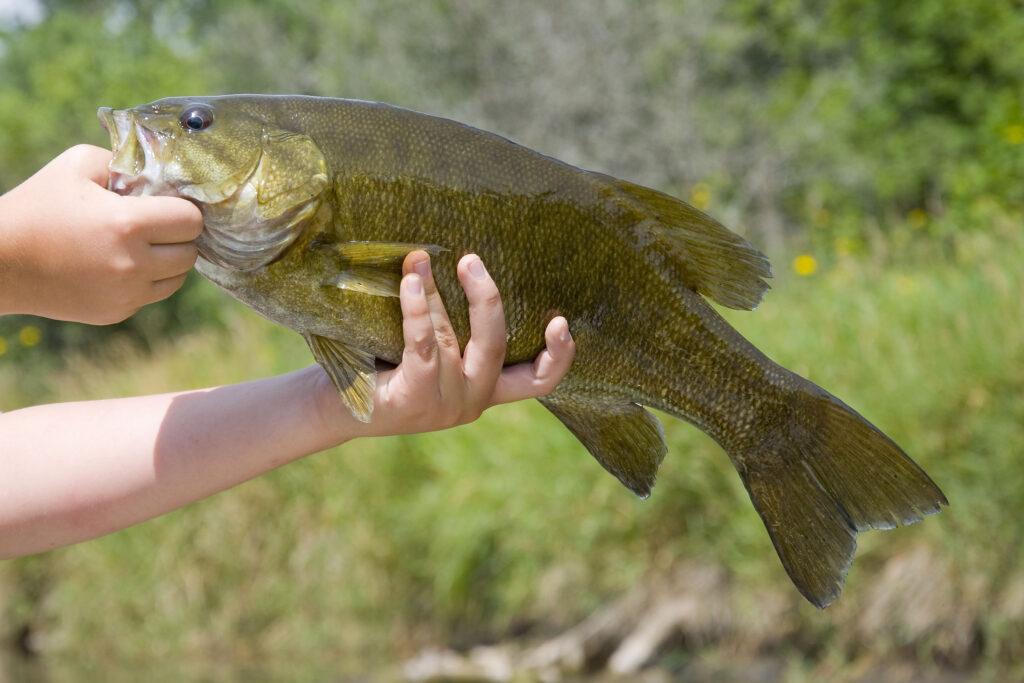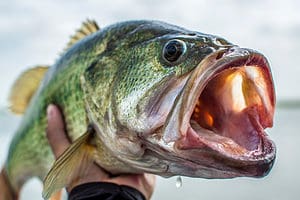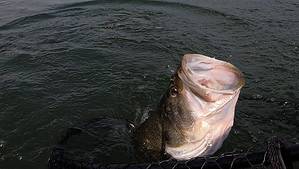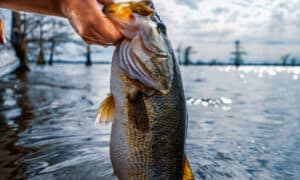Smallmouth Bass
The smallmouth bass (scientific name Micropterus dolomieu) is a popular freshwater game fish in the Centrarchidae family, otherwise known as sunfish. The species is indigenous to the lakes and rivers of eastern and central North America—especially those of the upper and middle Mississippi River, the Saint Lawrence River and Great Lakes, and the Hudson Bay basin. It is adaptable and has been spread by stocking and illegal introductions to other water bodies in Canada, the United States, and other regions and countries, where it has become an invasive species, disrupting different ecosystems. This fish is also known as a smallie, brownie, bronze bass, and bronzeback. It is prized for its fighting nature amongst catch-and-release anglers, but it also is prized for its flavor.

Smallmouth bass are popular game fish. Just how big can they get?
©Steve Oehlenschlager/Shutterstock.com
Smallmouth Size
Standard Sizes
The typical smallmouth bass weighs less than 10 pounds, and although they can reach a maximum length of approximately 27 inches, the more common size is 10-20 inches—as small as a cucumber or as long as a backscratcher. Largemouth bass, in comparison, tend to weigh up to 25 pounds and reach 30 inches long.
The Largest Smallmouth Bass on Record
The largest smallmouth bass on record was caught in 1955 by David Hayes. It weighed 11 pounds and 15 ounces and was caught in the Dale Hollow Reservoir on the border of Kentucky and Tennessee. He lost the title for a time, as someone filed an affidavit claiming that weight had been added to his catch without his knowledge. A polygraph test later indicated the testimony was false, returning the title to Hayes.

Unlike this smaller specimen, the largest smallmouth bass on record reached 11 pounds and 15 ounces.
©iStock.com/LaSalle-Photo
Best Places and Time of Year to Catch Smallmouth Bass
Generally speaking, smallmouth bass enjoy shallow waters, whether in rivers and streams, shallow lakes, or shallow bays and near the shores of larger lakes. They’re especially likely to be caught near rocks, logs, or swirling water eddies. Smallmouth bass can be caught not only in the wilds of their native waters but also in cool, stocked lakes and rivers throughout the U.S. and Canada.
Apart from these general guidelines, some bodies of water offer what is judged to be the best angling conditions for smallmouth bass. We offer a short list below.
Best Places to Catch Smallies
Lake Champlain
Lake Champlain, lying at the intersection of New York and Vermont in the U.S., and Quebec on the Canadian side, offers some shallow waters near its shorelines, though it is a deep lake—nearly 400 feet deep. The Vermont shoreline offers especially favorable waters, such as Carry Bay. Plattsburgh, New York, and Rouses Point, Canada, also offer good options.
St. Lawrence River
The St. Lawrence River has exceptional bass fishing and has hosted several fishing tournaments. Bays branching off the river, including Eel Bay and Chippewa Bay, have proven to be quite favorable to anglers. The shores of Ontario and New York’s Thousand Island regions are also worth exploring.
Lake St. Clair
Lake St. Clair, straddling the U.S. Canadian border between Lakes Erie and Huron, averages 11 feet in depth over a surface area of about 430 square miles. Smallmouth bass love shallow waters like these. Spring and fall are the best times of year to pursue “smallies” here.
Mille Lacs
Mille Lacs is recognized as one of the United States’ best lakes for smallmouth bass in Minnesota. It is the second-largest lake in the state and has a surface area of over 130,000 acres. Most of the lake has a depth of 20-38 feet, ideal for smallmouth bass, especially in the southern section over the lake’s gravelly bottom.
Lake Erie
Lake Erie, the shallowest of the Great Lakes, is ideal for smallmouth bass, creating a temperature range they crave. Although the lake can be deep in areas, the shoreline provides rocky habitats 15-40 feet deep. The sheer number of entry points along the shores of Michigan, Ohio, Pennsylvania, and New York, makes this a massive hunting ground for smallmouth bass. The eastern and western waters near Buffalo, New York, and Toledo and Sandusky, Ohio, are excellent spots for targeting this fish.

Smallmouth bass are excellent fighters at 10-20 inches long and weighing up to 10 pounds.
©K Steve Cope/Shutterstock.com
Best Time to Catch Smallmouth Bass
Smallmouth bass can be caught year-round, but winter is a fairly difficult time to find them. The haul can be pretty good from spring through fall. The best time of the year to pursue smallmouth is fall when they are beginning to prepare for winter, feeding heavily, and traveling in large schools. The best times of the day are early and during low light. However, any time is a good time for a fishing trip!
The photo featured at the top of this post is © RLS Photo/Shutterstock.com
Thank you for reading! Have some feedback for us? Contact the AZ Animals editorial team.






